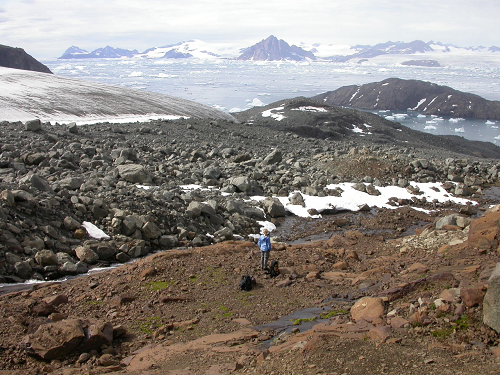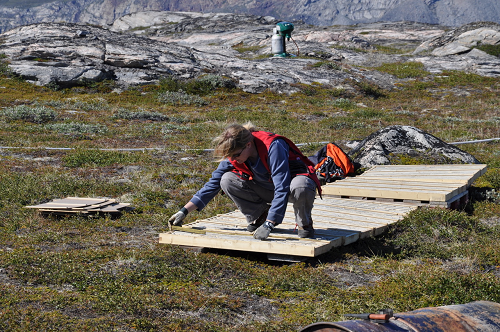Day, S., The Modern Geological Survey. Geoscientist 30 (6), 16-19, 2020
https://doi.org/doi: 10.1144/geosci2020-093, Download the pdf here
Sarah Day talks to British Geological Survey Director Karen Hanghøj about geoscience, outreach and why we need experts more than ever
 ‘When I was a student at the University of Copenhagen, we had various clubs – sedimentology, petrology, palaeontology and so on. You’d notice that, for example, the people studying petrology wouldn’t go to a talk about sedimentology because they thought it wasn’t relevant to them. Historically, we’ve closed in on ourselves a little bit.
‘When I was a student at the University of Copenhagen, we had various clubs – sedimentology, petrology, palaeontology and so on. You’d notice that, for example, the people studying petrology wouldn’t go to a talk about sedimentology because they thought it wasn’t relevant to them. Historically, we’ve closed in on ourselves a little bit.
‘I think the modern Geological Survey is beginning to change this.’
Karen Hanghøj took up her post as Director of the British Geological Survey in October 2019, having previously headed up the Department of Economic Geology and Petrology at the Geological Survey of Denmark and Greenland before managing EIT RawMaterials – a Knowledge and Innovation Community headquartered in Berlin.
‘All the things I’ve done have been a natural continuation, and that’s what attracted me to this role – it’s the culmination of where I’ve been trying to go.’
Academia and Industry
Hanghøj took her Masters and PhD at the University of Copenhagen, focusing on east Greenland, the breakup of the Atlantic and the igneous petrology of crustal and mantle rocks. At the same time, she was becoming interested in mineral exploration.
‘The very first year I did my Masters thesis in east Greenland, we were working in a very remote mountainous area, and there was a Canadian exploration company operating in the area, drilling for gold and platinum. They offered me a few weeks work, which I did every summer during my Masters and PhD studies. Ever since, I’ve maintained an interest in mineral exploration and industry alongside my academic work.’
Her background, then, makes her ideally suited to leading an organization which combines academic research with industry expertise.
‘The modern Geological Survey is very much about combining the basic geoscience with an understanding of the societal context. It’s about listening to the needs of society, through engaging with policy makers, industry, NGOs and the public. Coming to a Geological Survey has felt a bit like coming home.’
She wasn’t, she says, always determined to become a geoscientist.
 ‘My own path to becoming interested in geology is useful in thinking about how we attract others. I was interested in and fairly good at science and maths, and also quite ‘outdoors-y’. I liked things like camping and hiking.
‘My own path to becoming interested in geology is useful in thinking about how we attract others. I was interested in and fairly good at science and maths, and also quite ‘outdoors-y’. I liked things like camping and hiking.
‘When I finished high school, I had to choose a subject to study for the next six years – we had a different system in Denmark then. So it felt like a very big decision. I looked at various degrees in the sciences – medicine, veterinary science, engineering – and then I saw geology.
‘Denmark is more or less a big piece of moraine – there are almost no rocks or mountains – so when I looked at what I would learn about, I realized quickly that to become a geologist I would have to travel. Other than that, I didn’t really know what I was getting into, but very quickly, within the first semester, I knew I had made a perfect choice.
‘That’s perhaps one way to get people into the geosciences – to talk about how it gets you outside, and thinking about something bigger than yourself.’
Many audiences
Hanghøj sees outreach – in its many guises - as key to the work of the Geological Survey, and the future of the geosciences.
‘I’ve always been interested in it. I think it’s important to recognize that there are many different audiences. ‘Pure’ outreach involves communicating with the public through things like open days, popular science articles and social media, so we can demonstrate how important geoscience is. But it’s important not to mistake quantity for quality – some types of communication can’t be judged by the number of people you reach. If only ten people access our data on things like ground water, seismicity etc., but they’re the right ten people, then we’ve done our job well.
Some communication requires asking ‘if we don’t do this, is anyone else going to do it? And if not, and it’s critically important to society, then it’s important for us to do.’
Despite the work being done by the British Geological Survey and other organisations to promote the study of geoscience, student numbers are currently in decline. Hanghøj believes this is only partly down to a reputation as being linked with fossil fuel industries.
‘Yes, it’s partly that the subject’s reputation has suffered from links to mining and especially oil in recent years, but I don’t think that’s the entire story. I think young people today think about things in a different way. They’re attracted to new subjects like AI – and perhaps we haven’t done enough to show students that the geosciences are part of topics like that too. Young people have to navigate such a huge variety of options now – we need to get better at selling ourselves. I think the BGS definitely has a role to play here.’
Signal value
 Hanghøj is the first female Director of the Survey, founded in 1835 by Henry De la Beche. Unsurprisingly, it’s a subject she’s asked about often.
Hanghøj is the first female Director of the Survey, founded in 1835 by Henry De la Beche. Unsurprisingly, it’s a subject she’s asked about often.
‘It means a lot to me to be the director of an incredible geological research organization that’s been around for a long time, but it doesn’t mean a lot to me personally to be the first woman. I think what’s important is what it means to other people and the signal it sends – it’s about time!
‘I can tell from the reaction to the announcement that my appointment had a tremendous signal value for female geoscientists, and that’s incredibly important. I do sometimes wish we could focus on other things though. There’s always going to be an element of that – we want women to be visible at the top, but we also don’t want the most interesting thing about female directors to be that they’re female.
‘In the profession as a whole, we’re moving very slowly in the right direction but it is too slow. When I was a Masters student, we were probably around 30% women, and when I became a PhD student that cohort was also at least 30%. I’m not part of a 30% cohort any more.
‘There is something systematic that makes women leave the career path in geology, and we need to think really hard about it.
‘We have to start thinking differently, about the environment scientists work in as a whole. With diversity more widely, particularly ethnic diversity, we’re doing very badly. I think we’re still only beginning to understand why, and how we can change.’
A unique organisation
Despite the challenges, Hanghøj is happy to be back working at a Geological Survey, combining interests in academic research, societal applications and industry which have been a feature of her career so far.
‘It’s been a steep learning curve in many ways, but in others, not at all, because I feel so at home. I’m interested in the core research, but also in what society needs from us, and that’s what the modern Geological Survey is all about.
‘To be able to provide credible advice, we need to be experts. The great advantage of a Survey is you have a lot of different people who have similar experience and overlapping expertise. So if a new problem shows up in society, industry or government, we have the critical mass to respond and contribute to finding new solutions. That’s something pretty unique to an organisation like ours.’
All images: Karen Hanghøj in Greenland
